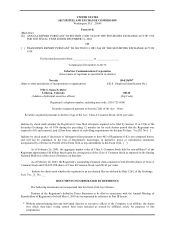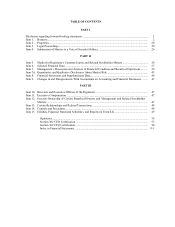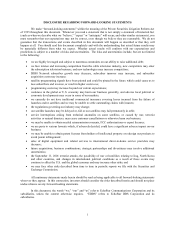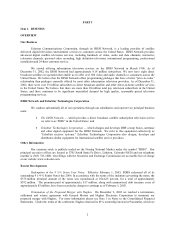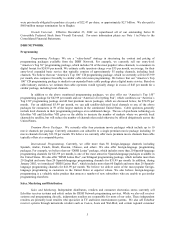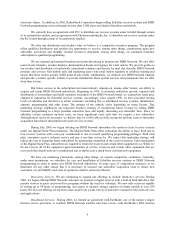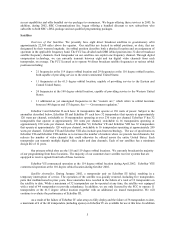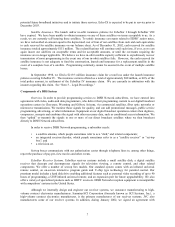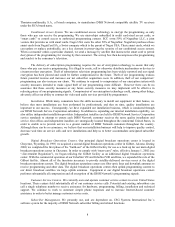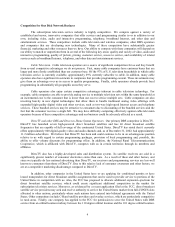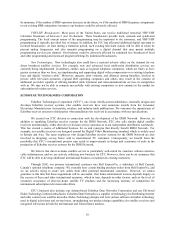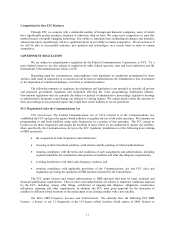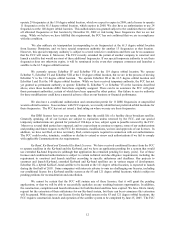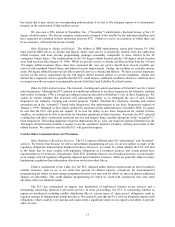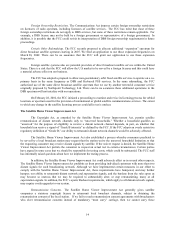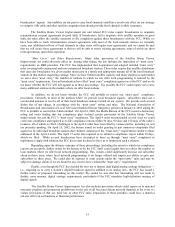Dish Network 2002 Annual Report Download - page 7
Download and view the complete annual report
Please find page 7 of the 2002 Dish Network annual report below. You can navigate through the pages in the report by either clicking on the pages listed below, or by using the keyword search tool below to find specific information within the annual report.5
access capabilities and offer bundled service packages to consumers. We began offering these services in 2003. In
addition, during 2002, SBC Communications Inc. began offering a bundled discount to new subscribers who
subscribe to both SBC’s DSL package and our qualified programming packages.
Satellites
Overview of Our Satellites. We presently have eight direct broadcast satellites in geostationary orbit
approximately 22,300 miles above the equator. Our satellites are located in orbital positions, or slots, that are
designated by their western longitude. An orbital position describes both a physical location and an assignment of
spectrum in the applicable frequency band. The FCC has divided each DBS orbital position into 32 direct broadcast
satellite frequency channels. Each transponder on our satellites can exploit one frequency channel. Through digital
compression technology, we can currently transmit between eight and ten digital video channels from each
transponder, on average. The FCC licensed us to operate 96 direct broadcast satellite frequencies at various orbital
positions including:
• 21 frequencies at the 119 degree orbital location and 29 frequencies at the 110 degree orbital location,
both capable of providing service to the entire continental United States;
• 11 frequencies at the 61.5 degree orbital location, capable of providing service to the Eastern and
Central United States;
• 24 frequencies at the 148 degree orbital location, capable of providing service to the Western United
States;
• 11 additional as yet unassigned frequencies in the “western arc,” which refers to orbital locations
between 148 degrees and 175 degrees. See “— Government regulation.”
EchoStar I and EchoStar II each have 16 transponders that operate at 130 watts of power. Subject to the
anomalies described below, EchoStar III and EchoStar IV each have 32 transponders that operate at approximately
120 watts per channel, switchable to 16 transponders operating at over 230 watts per channel. EchoStar V has 32
transponders that operate at approximately 110 watts per channel, switchable to 16 transponders operating at
approximately 220 watts per channel. Each of EchoStar VI, EchoStar VII and EchoStar VIII has 32 transponders
that operate at approximately 120 watts per channel, switchable to 16 transponders operating at approximately 240
watts per channel. EchoStar VII and EchoStar VIII also include spot-beam technology. The use of spot-beams on
EchoStar VII and EchoStar VIII enables us to increase the number of markets where we provide local channels, but
reduces the number of video channels that could otherwise be offered across the entire United States. Each
transponder can transmit multiple digital video, audio and data channels. Each of our satellites has a minimum
design life of 12 years.
Our primary orbital slots are the 110 and 119 degree orbital locations. We currently broadcast the majority
of our programming from these locations. The majority of our customers have satellite receiver systems that are
equipped to receive signals from both of these locations.
EchoStar VII commenced operation at the 119 degree orbital location during April 2002. EchoStar VIII
commenced operation at the 110 degree orbital location during October 2002.
Satellite Anomalies. During January 2002, a transponder pair on EchoStar III failed, resulting in a
temporary interruption of service. The operation of the satellite was quickly restored. Including five transponders
pairs that malfunctioned in prior years, these anomalies have resulted in the failure of a total of 12 transponders on
the satellite to date. While a maximum of 32 transponders can be operated at any time, the satellite was equipped
with a total of 44 transponders to provide redundancy. In addition, we are only licensed by the FCC to operate 11
transponders at the 61.5 degree orbital location (together with an additional six leased transponders). We will
continue to evaluate the performance of EchoStar III.
As a result of the failure of EchoStar IV solar arrays to fully deploy and the failure of 38 transponders to date,
a maximum of 6 of the 44 transponders (including spares) on EchoStar IV are available for use at this time. In addition

